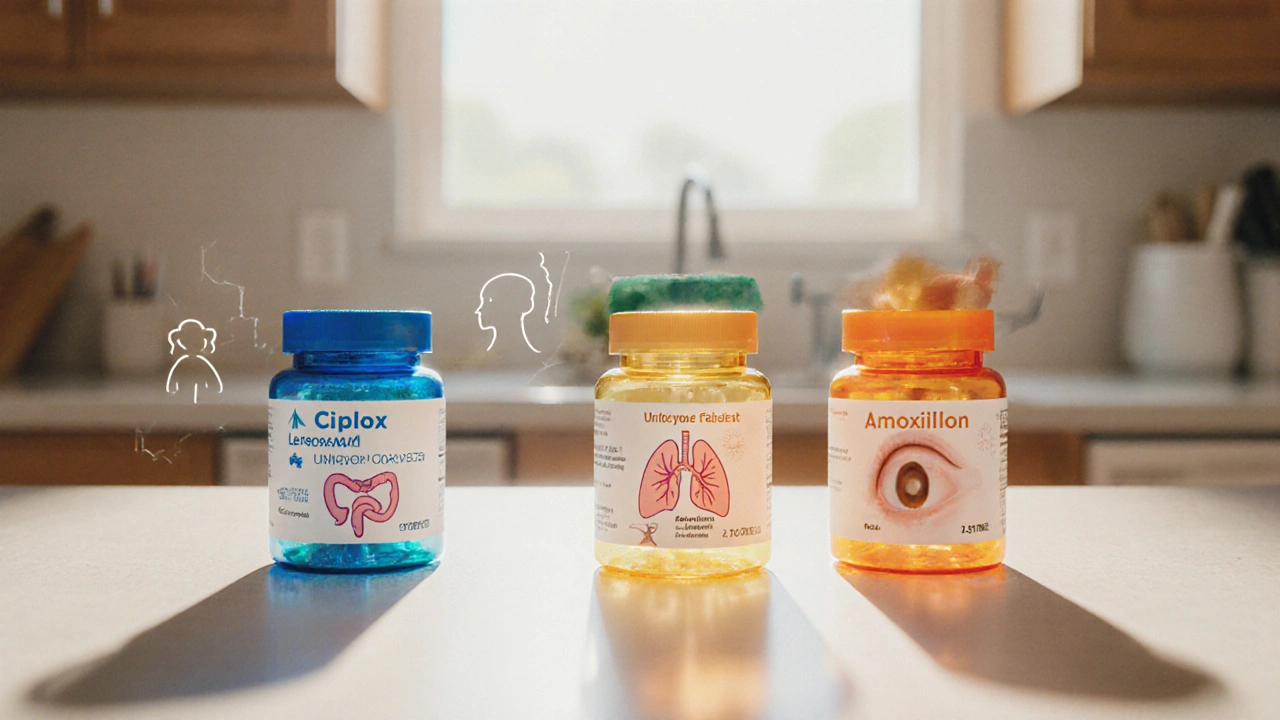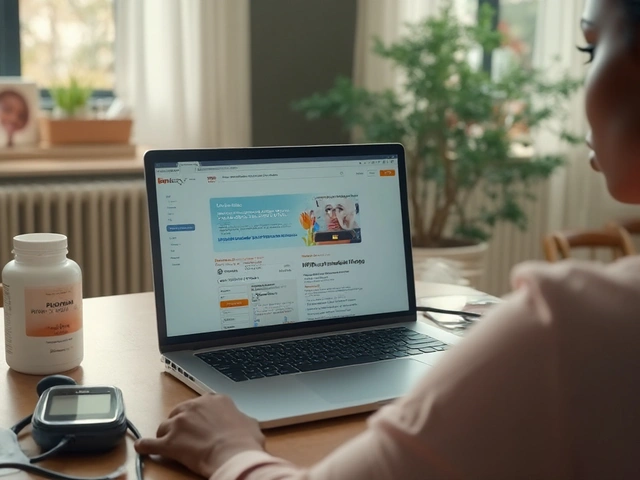Antibiotic Selection Guide
Select the following options to get a recommended antibiotic based on infection type and patient considerations:
Recommended Antibiotic:
Reasoning:
Ciplox is a brand‑name oral formulation of ciprofloxacin, a fluoroquinolone antibiotic that interferes with bacterial DNA replication. It’s widely prescribed for urinary‑tract infections, respiratory infections and certain gastrointestinal bugs. Understanding how Ciplox works, its safety profile, and how it measures up against other agents helps clinicians and patients make smarter choices.
Mechanism of Action and Drug Class
Fluoroquinolones are a class of broad‑spectrum antibiotics that target the bacterial enzymes DNA gyrase and topoisomeraseIV. By inhibiting these enzymes, they prevent DNA supercoiling and block bacterial cell division. Ciprofloxacin (the active ingredient in Ciplox) has a high affinity for DNA gyrase in Gram‑negative organisms, which explains its potency against Escherichia coli and Klebsiella pneumoniae.
Typical Clinical Indications
Doctors prescribe Ciplox for a range of infections where Gram‑negative bacteria dominate. Common uses include uncomplicated urinary‑tract infection (UTI), acute bacterial prostatitis, and traveller’s diarrhoea caused by Campylobacter jejuni. It is also effective for certain respiratory infections, such as acute exacerbations of chronic bronchitis when Pseudomonas aeruginosa is suspected.
Safety Profile and Contra‑indications
While Ciplox is generally well‑tolerated, fluoroquinolones carry class‑wide warnings. The most serious risk is tendon rupture, especially in older adults or those on corticosteroids. Other notable adverse effects include QT‑interval prolongation, peripheral neuropathy, and photosensitivity. Tendonitis can develop within days of treatment, so clinicians advise patients to avoid vigorous exercise during therapy.
Key Alternatives to Ciplox
When Ciplox isn’t suitable-because of allergies, resistance patterns, or safety concerns-several other agents are considered. Below are the most frequently used alternatives, each introduced with a concise definition.
Levofloxacin is a newer fluoroquinolone that offers better activity against atypical respiratory pathogens such as Mycoplasma pneumoniae. It shares the DNA‑gyrase inhibition mechanism but tends to have a longer half‑life, allowing once‑daily dosing.
Moxifloxacin belongs to the same class but provides broader Gram‑positive coverage, making it useful for community‑acquired pneumonia where Streptococcus pneumoniae is a concern.
Amoxicillin is a beta‑lactam penicillin that inhibits cell‑wall synthesis. It is the first‑line choice for many infections caused by Gram‑positive bacteria, such as otitis media and certain sinus infections.
Azithromycin is a macrolide antibiotic that blocks bacterial protein synthesis. It is favored for atypical organisms (e.g., Chlamydia trachomatis) and for patients who cannot tolerate fluoroquinolones.
Doxycycline is a tetracycline that also targets protein synthesis. It works well for tick‑borne illnesses and is sometimes used as an alternative for uncomplicated UTIs when resistance to ciprofloxacin is high.
Side‑Effect Profiles at a Glance
Every antibiotic carries its own set of adverse reactions. Below is a quick snapshot:
- Ciplox: tendon rupture, QT prolongation, photosensitivity.
- Levofloxacin: similar tendon risks, plus possible CNS effects (dizziness, headache).
- Moxifloxacin: higher risk of liver enzyme elevations.
- Amoxicillin: gastrointestinal upset, allergic rash.
- Azithromycin: potential for cardiac arrhythmias (especially with other QT‑prolonging drugs).
- Doxycycline: sunburn, esophageal irritation.

Resistance Landscape
Antibiotic resistance is a moving target. Fluoroquinolones, including Ciplox, face rising resistance mediated by mutations in the quinolone‑resistance‑determining region (QRDR) of DNA gyrase and efflux pump overexpression. In many parts of sub‑Saharan Africa, >30% of E. coli urinary isolates show reduced susceptibility to ciprofloxacin.
Beta‑lactams like amoxicillin encounter beta‑lactamase enzymes, which can be countered by adding clavulanic acid (forming Augmentin). Macrolides and tetracyclines encounter methylase‑mediated ribosomal protection. Understanding local antibiograms is essential before picking an agent.
Comparison Table
| Antibiotic | Drug Class | Typical Spectrum | Standard Adult Dose | Major Side‑Effects | Resistance Concerns |
|---|---|---|---|---|---|
| Ciplox | Fluoroquinolone | Gram‑negatives (E. coli, P. aeruginosa) | 500mg PO BID | Tendon rupture, QT prolongation | QRDR mutations, efflux pumps |
| Levofloxacin | Fluoroquinolone | Gram‑negatives + atypicals | 750mg PO QD | Tendon issues, CNS effects | Similar to ciprofloxacin |
| Moxifloxacin | Fluoroquinolone | Gram‑pos + respiratory | 400mg PO QD | Liver enzyme rise, QT prolongation | Lower resistance overall |
| Amoxicillin | Beta‑lactam (penicillin) | Gram‑pos, some Gram‑neg | 500mg PO TID | GI upset, allergic rash | Beta‑lactamases |
| Azithromycin | Macrolide | Atypicals, some Gram‑pos | 500mg PO QD ×5days | Cardiac arrhythmia risk | Macrolide‑mediated methylation |
| Doxycycline | Tetracycline | Broad‑spectrum, tick‑borne | 100mg PO BID | Photosensitivity, esophagitis | Efflux pumps, ribosomal protection |
How to Choose the Right Antibiotic
Picking an agent isn’t just about spectrum; you need to balance efficacy, safety, local resistance patterns, patient comorbidities, and convenience.
- Identify the likely pathogen. Urine cultures point to E.coli, while atypical pneumonia suggests Mycoplasma.
- Check the regional antibiogram. If ciprofloxacin resistance exceeds 20% for the suspected bug, consider a beta‑lactam or macrolide.
- Assess patient risk factors. Elderly patients on steroids should avoid fluoroquinolones due to tendon‑rupture risk.
- Factor in dosing convenience. Once‑daily levofloxacin may improve adherence compared with thrice‑daily amoxicillin.
- Watch for drug‑drug interactions. Azithromycin and fluoroquinolones both prolong QT; avoid combining with other QT agents.
Related Concepts: Stewardship and Future Directions
Antibiotic stewardship programs aim to curb unnecessary fluoroquinolone use, reserving them for cases where no safer alternative exists. Emerging research on novel quinolone‑binding site inhibitors promises to overcome QRDR‑mediated resistance, but these agents are still in PhaseII trials.
In the meantime, clinicians can reduce resistance pressure by employing short‑course therapy (typically 3‑5days for uncomplicated UTIs) and by selecting narrow‑spectrum agents whenever culture data allow.
Practical Tips for Patients on Ciplox
- Stay hydrated - it helps prevent crystal formation in the kidneys.
- Avoid excessive sunlight - wear sunscreen and a hat.
- Skip high‑impact sports for at least a week after finishing therapy.
- Inform your doctor about any corticosteroid use or a history of tendon problems.
Frequently Asked Questions
Is Ciplox safe for pregnant women?
Fluoroquinolones, including ciprofloxacin, are generally avoided during pregnancy because animal studies have shown joint cartilage damage in developing fetuses. If an infection demands treatment, doctors usually opt for beta‑lactams such as amoxicillin or cephalosporins.
Can I take Ciplox with antacids?
Yes, but separate them by at least two hours. Antacids containing magnesium or aluminum can bind ciprofloxacin and lower its absorption, reducing effectiveness.
What should I do if I develop tendon pain while on Ciplox?
Stop the medication immediately and contact your healthcare provider. Early discontinuation can prevent a full‑blown rupture. You’ll likely be switched to a non‑fluoroquinolone antibiotic.
How does ciprofloxacin resistance develop?
Resistance arises mainly through mutations in the quinolone‑resistance‑determining region of DNA gyrase and topoisomeraseIV, plus overexpression of efflux pumps that expel the drug from bacterial cells. Overuse of fluoroquinolones speeds up this selection pressure.
When would a doctor choose amoxicillin over Ciplox?
If the infection is caused by Gram‑positive organisms like Streptococcus pneumoniae or Haemophilus influenzae, amoxicillin offers a safer side‑effect profile and avoids fluoroquinolone‑related tendon risk. Culture results confirming susceptibility guide this switch.
Is a 3‑day course of Ciplox enough for a simple UTI?
Current guidelines endorse a 3‑day regimen (500mg PO BID) for uncomplicated urinary‑tract infections caused by susceptible E.coli, provided the patient has no complicating factors like pregnancy or renal impairment.





Scott Davis
September 26, 2025 AT 22:57Ciprofloxacin resistance is climbing in many regions.
Pam Mickelson
October 3, 2025 AT 21:37The article does a solid job outlining Ciplox's mechanism and its side‑effect profile. I appreciate the clear tables that compare dosing and resistance concerns. For anyone worried about tendon issues, the precaution about avoiding high‑impact sports is especially useful. Overall, a well‑structured guide that balances detail with readability.
Brenda Hampton
October 10, 2025 AT 20:17When we talk about antibiotics like Ciplox, it's crucial to keep stewardship at the forefront of our minds. First, understanding the local antibiogram can prevent unnecessary use of a broad‑spectrum fluoroquinolone when a narrow‑spectrum beta‑lactam would suffice. Second, the duration of therapy matters; for uncomplicated UTIs a three‑day course is often enough, reducing selective pressure. Third, patient-specific factors such as age, renal function, and concomitant medications shape the risk‑benefit calculation. Fourth, the tendon‑rupture warning isn’t just a footnote – it’s a real concern for seniors on steroids. Fifth, drug interactions like antacids can blunt ciprofloxacin absorption, so timing matters. Sixth, the emergence of QRDR mutations underscores why fluoroquinolone resistance can spread rapidly if we overuse them. Seventh, alternative agents such as amoxicillin or azithromycin have their own pros and cons, but they generally carry a safer side‑effect profile for many patients. Eighth, clinicians should document the indication clearly in the medical record to justify fluoroquinolone use. Ninth, patient education about staying hydrated and avoiding intense exercise can mitigate tendon risk. Tenth, many healthcare systems now flag high‑risk prescriptions in electronic health records, prompting a double‑check. Eleventh, insurance formularies sometimes require step‑therapy before approving Ciplox, which can delay appropriate treatment. Twelfth, microbiology labs that provide rapid susceptibility results enable targeted therapy sooner. Thirteenth, pharmacists can play a pivotal role by reviewing medication histories for previous fluoroquinolone exposure. Fourteenth, global surveillance shows resistance rates vary widely, so what works in one region may be ineffective elsewhere. Fifteenth, continued research into novel quinolone‑binding site inhibitors offers hope for future options, but until they’re approved, judicious use remains key.
Ada Lusardi
October 16, 2025 AT 15:11Wow, that's a lot to take in! 🌟 It's amazing how many factors play into a single prescription decision. Thanks for breaking it down so clearly! 🙌
Joe V
October 20, 2025 AT 02:31Ah, the classic "too many points" approach – as if anyone actually reads beyond the first three sentences. Nevertheless, your enthusiasm is noted, though perhaps a tad excessive.
Calvin Smith
October 24, 2025 AT 17:37Sure, keep throwing sprinklings of jargon about QRDR and efflux pumps; it's not like everyday folks need practical advice on staying hydrated or skipping the gym after a course.
Lara A.
October 28, 2025 AT 17:51Everyone's so blind to the fact that the pharma giants are secretly programming ciprofloxacin-resistant bacteria!!; they want us sick, they want us dependent!!!; don't be fooled!!!
Gayatri Potdar
October 31, 2025 AT 01:24Oh please, the "pharma giants" narrative is older than the internet; it's just a gimmick to scare people away from useful meds!!!; stay rational!!!
Ashishkumar Jain
November 4, 2025 AT 02:37hey folks, just wanted 2 say that using ciplox responsibly is key 2 keep it workin, stay hydrated u know, and avoid heavy lifting for a bit after finishin the meds.
Ram Dwivedi
November 7, 2025 AT 13:57👍 Absolutely! Hydration helps prevent crystal formation, and limiting intense activity reduces tendon strain. Also, remember to separate antacids by at least two hours for proper absorption. 🌿💊
Marcella Kennedy
November 12, 2025 AT 05:04I love how thorough the guide is, but let me add a few friendly reminders. First, always double‑check the allergy section; fluoroquinolone cross‑reactivity is rare but still worth confirming. Second, if a patient reports any tendon soreness, pausing the medication and consulting a physician is non‑negotiable. Third, the cost‑effectiveness of generic ciprofloxacin can be a boon for uninsured patients, provided resistance rates are low. Fourth, use the shortest effective duration to curb resistance development – three days for uncomplicated UTIs is often sufficient. Fifth, educate patients about the importance of completing the full course, even if symptoms resolve early, to prevent sub‑therapeutic exposure that fosters resistance. Lastly, keep an eye on local resistance trends; they can shift quickly, and staying informed helps you make smarter prescribing choices.
Jamie Hogan
November 16, 2025 AT 06:17Indeed your points are well taken however brevity could serve better